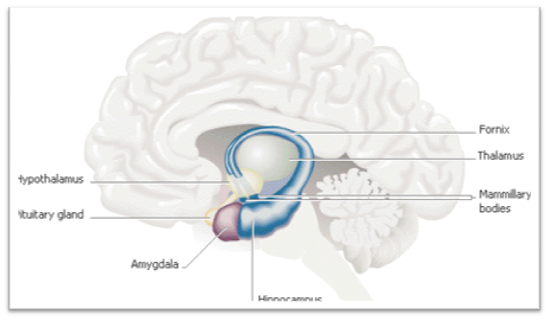Posts Tagged ‘Limbic System’
The Human Brain
| Your brain can be considered the most complex organ in your body and the centerpiece of your nervous system. Although your brain works as a unified whole, neuroscientists can identify areas within it that perform specific functions. Your brain is organized into three interconnected layers: the central core, limbic system, and cerebral cortex, all of which contain structures that regulate everyday life. Explore the human brain and its role in regulating your life. |

The Brain’s Functions II: Overseeing Emotions and Survival
What brain structures are involved in experiencing emotion?
The limbic system, a network of brain structures and pathways, helps regulate emotional behavior.
One of these structures the amygdala comes into play in experience of such intense emotions as anger, fear, or joy.
A prominent part of the limbic system is the hypothalamus—the brain’s most direct link to the body glands that are active in emotions. The master gland the pituitary gland, is connected to the hypothalamus.
The hypothalamus plays a role in maintaining Homeostasis, the state of dynamic equilibrium among physiological processes.
The medulla is also responsible for coordinating a number of essential bodily processes, including breathing, heart rate, and digestion.
How are our body functions regulated to keep us alive?
The autonomic nervous system (ANS) exercises more or less independent control over the endocrine glands, the heart muscles, and the muscles of the body’s organs and blood vessels. It helps regulate breathing, heart rate, blood pressure and digestion; in times of emergency it works in conjunction with the endocrine glands to mobilize the body’s resources.
The endocrine glands influence behavior by secreting hormones into the bloodstream. The most important endocrine glands are the following:

- The pineal, which affects sleep-waking rhythms and mood.
- The pituitary, which produces hormones that control growth, cause sexual development at puberty, and regulate other glands.
- The parathyroid, which maintain a normal state of excitability of the nervous system.
- The thyroid, which regulates metabolism and affects levels of body activity, temperature, and weight.
- The adrenals, which secrete the powerful stimulants epinephrine (active in states of emergency or fear) and norepinephrine (active during physical effort or anger).
- The pancreas, which governs blood sugar level.
- The female ovaries and male
testes, which regulate sexual characteristics and behavior.

|
The Brain’s Functions II: Overseeing Emotions and Survival: Limbic System |
|
|
Limbic System The Limbic System is a group of brain structures that play a role in emotion, memory, and motivation. For example, electrical stimulation of the amygdala in laboratory animals can provoke fear, anger, and aggression. The hypothalamus regulates hunger, thirst, sleep, body temperature, sexual drive, and other functions. |
|
|
Homeo-stasis |
A state of equilibrium, or balance, in the physiological systems within the human body. |
|
Limbic System |
The set of interconnected structures and pathways in the brain involved with emotion and memory. |
|
Amy-g-dala |
The part of the limbic system that plays a role in intense positive or negative emotions. |
|
Hypo-thala-mus |
The portion of the limbic system that serves as a mediator between the brain and the body and helps control metabolism, sleep, hunger, thirst, body temperature, sexual behavior, and emotions. |
|
Pit-u-i-tary Gland |
The master endocrine gland, which secrets hormones controlling growth and sexual development at puberty and regulating other endocrine glands. |
|
The Brain’s Functions II: Overseeing Emotions and Survival: Definitions |
|
|
Endocrine glands |
Glands that discharge hormones directly into the bloodstream, bringing about a variety of physiological and psychological changes. |
|
Medulla |
The structure in the brain stem that helps regulates breathing, heartbeat, blood pressure, and digestion. |
|
Autonomic nervous system (ANS) |
The neural network connecting the CNS with glands and smooth muscles, involved in maintaining Homeostasis. |
|
Para-sympathetic division of the ANS |
A part of the nervous system made up of scattered ganglia near the glands of the muscles of organs. It helps maintain functions such as heartbeat and digestion. |
|
Sympathetic division of the ANS |
Long chains of ganglia that extend down the sides of the spinal cord and activate the glands and smooth muscle for “fight” or “flight” |



![Reblog this post [with Zemanta]](https://i0.wp.com/img.zemanta.com/reblog_e.png)
